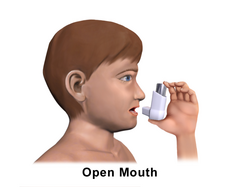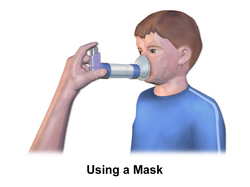Using an asthma inhaler
| Using an asthma inhaler | |
|---|---|
 | |
| Asthma Inhaler | |
| Specialty | General medicine |
| Indications | Asthma, COPD[1] |
| Types | Direct with mouthpiece, with spacer, mask and spacer[2] |
Correct use of an asthma inhaler contributes to preventing asthma symptoms by breathing the medicine straight into the lungs.[2] The same applies to using an asthma inhaler for other lung conditions such as COPD.[1] Several types of inhalers are available and vary in how they are used.[3] A spacer, with or without a mask may be required.[2]
Use of asthma inhalers is common and their incorrect use is frequently seen, particularly in children and the elderly.[3]
Use
Pressurised meter-dosed inhalers (pMDI)
1. The mouthpiece is removed and the inhaler is shaken for 5–10 seconds.[2]
2. The inhaler is gripped with mouthpiece on the bottom and canister on top. A finger is placed on the canister to allow for delivery of medicine.[2]
3. Once complete exhalation is done, mouth is placed over mouthpiece.
4. As inhalation begins, the canister is pressed down to releases the medicine into the lungs.
5. Slow deep breathing is continued and breath is held for 5–10 seconds, keeping the medicine in the lungs and preventing escape of aerosolized form of the medicine.
6. Complete exhalation is done again. If multiple puffs of the medicine have to be taken, steps 1–5 are repeated after waiting for 15–30 seconds.
7. Mouthpiece is replaced.
An alternative method is using a spacer placed at the mouthpiece of a meter-dosed inhaler while keeping the mouth at the end of the spacer.[2] Deep breathing is done to be ready for the delivery of the medicine to the lungs, and then the canister is pressed down.[2] This minimizes the need for coordination of breathing with inhaler activation.[2]
Dry powder inhalers
1. Inhaler medication chamber is prepared (this will be different based on the type of inhaler but will involve preparing and opening the chamber with the medication)
2. The inhaler is held with the chamber pointing towards the patient and complete exhalation is done with their head turned away from the inhaler.
3. Mouth is placed over the chamber and a quick, deep breath is taken allowing medication to dispense in the lungs.
4. Breath is held for 5–10 seconds and then slow exhalation is done.
5. After waiting for a few minutes, steps 1-4 are repeated if another dose is needed.
Soft mist inhalers
1. The inhaler is primed by loading the cartridge and discharging the inhaler until a fine mist is visible.
2. Once complete exhalation is done, mouth is placed around the mouthpiece while leaving space for the small holes on the side of the mouthpiece.
3. Slow inhalation is done while simultaneously pressing the button to release the medication.
4. Breath is held for 5–10 seconds.
5. Slow exhalation is done and steps 1-4 are repeated if another dose of medication is required after waiting for a few minutes.
If inhaler is used everyday, the inhaler usually has to be primed the first time using a new cartridge, but it may need to be primed again if it has not been used in multiple days.
After use
If using inhaled corticosteroids, rinse mouth out directly after use of inhaler.[4] Along with cleaning the teeth and general good oral hygiene, this helps to prevent oral candidiasis.[5]
Side effects
-
Oral candidiasis can occur following incorrect use of steroid inhaler[5]
-
Burn from repeated direct inhaler use on skin[6]
References
- ↑ 1.0 1.1 Melani, Andrea S. (August 2021). "Inhaler technique in asthma and COPD: challenges and unmet knowledge that can contribute to suboptimal use in real life". Expert Review of Clinical Pharmacology. 14 (8): 991–1003. doi:10.1080/17512433.2021.1929922. ISSN 1751-2441. PMID 33983092. Archived from the original on 2022-04-17. Retrieved 2022-10-03.
- ↑ 2.0 2.1 2.2 2.3 2.4 2.5 2.6 2.7 "CDC - Asthma - Using an Asthma Inhaler Videos". www.cdc.gov. 27 December 2018. Archived from the original on 1 September 2022. Retrieved 3 October 2022.
- ↑ 3.0 3.1 Usmani, Omar S (14 March 2019). "Choosing the right inhaler for your asthma or COPD patient". Therapeutics and Clinical Risk Management. 15: 461–472. doi:10.2147/TCRM.S160365. ISSN 1176-6336. PMID 30936708. Archived from the original on 2 August 2022. Retrieved 3 October 2022.
- ↑ "How to use a pMDI inhaler". Asthma + Lung UK. Archived from the original on 31 March 2022. Retrieved 4 October 2022.
- ↑ 5.0 5.1 Hughes, Stephen; Troise, Oliver TroiseCorresponding author Oliver (3 November 2020). "Oral candidiasis: causes, types and treatment". The Pharmaceutical Journal. Archived from the original on 26 May 2022. Retrieved 11 October 2022.
- ↑ Bonniaud, Philippe; Georges, Marjolaine; Blanc-Caille, Marion; Collet, Evelyne; Camus, Philippe (1 January 2011). "Salbutamol inhaler misuse resulting in skin burn". Journal of Allergy and Clinical Immunology. 127 (1): 295. doi:10.1016/j.jaci.2010.09.042. ISSN 0091-6749. Archived from the original on 10 October 2022. Retrieved 10 October 2022.




![Oral candidiasis can occur following incorrect use of steroid inhaler[5]](https://nccommons.org/media/thumb/3/39/Acute_pseudomembranous_candidosis.png/250px-Acute_pseudomembranous_candidosis.png)
![Burn from repeated direct inhaler use on skin[6]](https://nccommons.org/media/thumb/f/ff/PMC3014811_CRIM2010-201809.001.png/250px-PMC3014811_CRIM2010-201809.001.png)